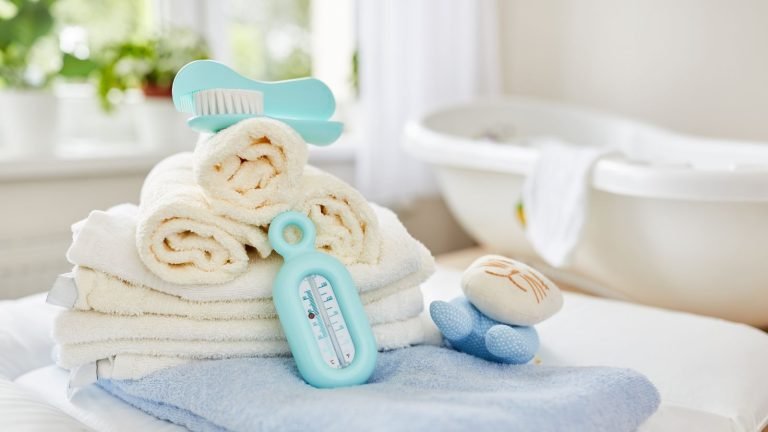Tiny Nursery, Big Style: 27 – Small Nursery Ideas That Maximize Every Inch

Turning a small space into a cozy nursery might seem tough initially, but with the right approach, it can become an exciting opportunity for creativity.
I’m here to walk you through practical and stylish “Small Nursery Ideas” to optimize limited space without sacrificing decor or functionality. Discover how to maximize floor space, utilize wall space for storage with floating shelves and pegboards, and select multi-functional furniture like a dresser that also serves as a changing table.
Learn the benefits of a mini crib as a space-saving solution, the best methods to declutter with smart storage options like baskets and drawers, and ways to enhance the room with natural light.
Together, we’ll make every square inch of your small nursery a comfortable, organized haven for your little one.
Key Takeaway – Small Nursery Ideas
- Utilize vertical space with wall-mounted shelves, pegboards, and over-the-door organizers to keep essentials organized without consuming floor space.
- Opt for multi-functional and convertible furniture pieces, like cribs with built-in storage or dressers that can serve as changing tables, to save room and adapt as your child grows.
- To maximize every inch of the nursery, incorporate smart storage solutions, such as rolling bins under the crib, baskets, and slim shelving units in underutilized areas.
1. Embrace Compact Sleeping Solutions
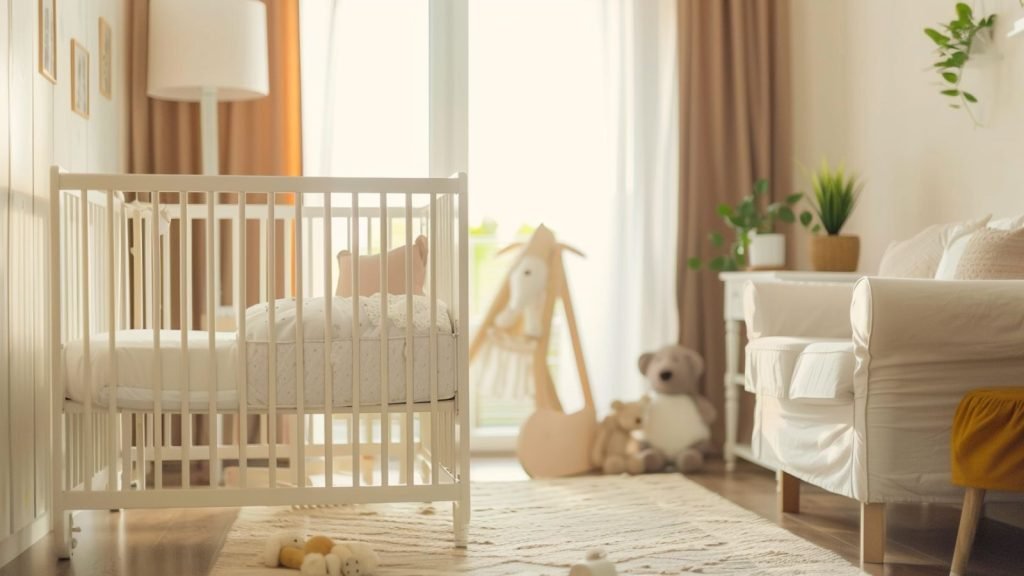
Opt for a compact baby crib to maximize space in your tiny nursery. Mini cribs are perfect for small nurseries, making the room feel larger and more inviting for your precious baby. These cribs often come with built-in storage, helping you keep essential items like diapers and wipes within easy reach. This choice demonstrates that even a small space can be stylish and functional.
2. Creative Storage Options Under the Crib
Utilize the area under the crib as an effective way to free up valuable floor space. Rolling bins or storage ottomans placed beneath the crib offer a handy spot to store baby essentials, from stuffed animals to extra bedding. This clever storage solution reduces clutter, proving that small nurseries don’t have to sacrifice organization or style.
3. Opt for a Versatile Dresser
Replace a traditional changing table with a versatile dresser that doubles as a changing area. This approach saves significant space and contributes to a neatly decorated nursery. By choosing a dresser that can accommodate a changing pad on top, you ensure everything you need is accessible while maximizing the use of every square inch of your nursery.
4. Smart Use of Vertical Space
Maximize storage without consuming floor space by utilizing wall space effectively. Installing floating shelves or hooks can help you organize essentials and display decor, making the most of the vertical space in your nursery. This method is especially useful for storing and displaying items like books, diaper supplies, and decorative pieces, keeping the nursery tidy and spacious.
How to Organize a Bookshelf for Kids is a great strategy to consider when setting up your baby’s nursery. A well-organized bookshelf not only saves space but also makes it easier for your child to access books as they grow.
5. Multipurpose Furnishings
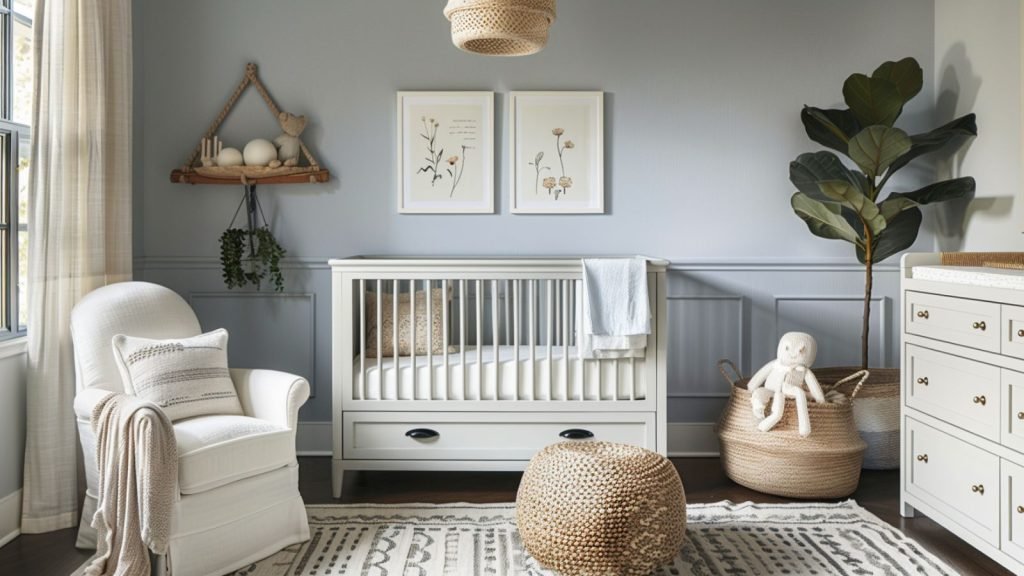
Invest in furniture for multiple purposes, such as a crib with built-in drawers or a storage ottoman. These pieces are crucial for saving space and adding functionality to your nursery. Multipurpose furniture allows you to create a perfect, clutter-free room for your baby by cleverly combining storage and style in each piece of furniture.
6. Reimagine the Closet (removing the closet doors, extra room)
Consider removing the closet door to open up more space in the nursery. This can make the room feel larger and more accessible, offering new possibilities for organizing and decorating. Use the closet space to install additional shelving, hang clothes, or store a small dresser, effectively utilizing every inch of available space.
7. Sleek, Space-Saving Rocking Chair (piece of furniture, every square)
Select a slim, modern rocking chair that doesn’t take up too much room. This ensures a comfortable place to soothe your baby without overcrowding the nursery. Look for a chair that fits well in a corner, maximizing floor space and contributing to a functional and chic nursery design.
8. Light and Airy Color Palette (decorate larger room)
Use neutral or light colors to paint the nursery walls. Light colors make small spaces feel bigger and brighter, especially when complemented by natural light. Decorate with soft, cozy textiles and light-colored decor to enhance the sense of space, making the nursery feel airy and welcoming.
9. Declutter and Organize Regularly (time to declutter, feel even smaller)
Regularly sort through your baby’s items, keeping only what you need. A clutter-free nursery feels more spacious and serene. Use storage baskets, drawers, and closet organizers to keep everything in its place, making it easier to find what you need and keeping the room tidy.
Setting Up a Nursery on a Budget is another essential consideration. Making cost-effective choices allows you to create a stylish nursery without overspending
10. Reflect and Amplify Light (natural light makes a big difference)
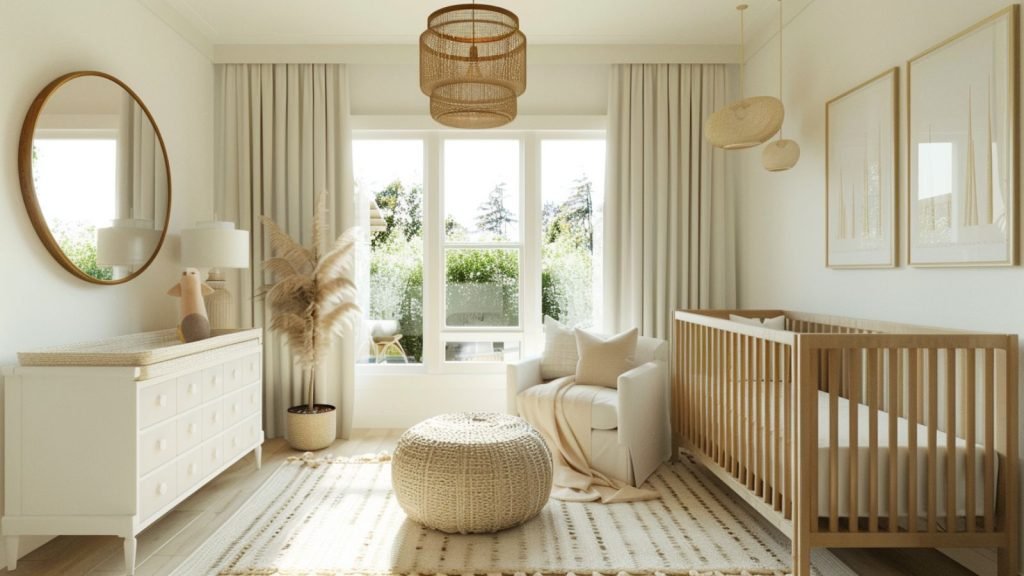
Maximize natural light in the nursery to make it feel more open. Use mirrors to reflect light around the room, amplifying the sense of space. Avoid heavy curtains, opting for sheer fabrics that allow light in while providing privacy, making the nursery feel brighter and larger.
11. Ingenious Wall-mounted Solutions (decorate baby’s nursery)
Adopt wall-mounted storage solutions like shelves or hooks to organize and display nursery items. This strategy saves floor space while adding to the decor of your baby’s nursery. Use shelves for books and decor and hooks for hanging clothes or diaper bags, keeping essentials within reach and the nursery orderly.
12. Convertible Furniture for Longevity (working with limited space, multipurpose furniture)
Invest in furniture that grows with your child. A convertible crib that turns into a toddler bed or a changing table that becomes a regular dresser offers long-term value and saves space. This flexible furniture minimizes the need to buy new pieces as your child grows, making it an ideal choice for small nurseries.
13. Light Fixtures as Space Savers (take up too much room, maximize storage)
Choose ceiling or wall-mounted light fixtures to illuminate the nursery without sacrificing space. Avoid floor lamps that can clutter a small room. Well-chosen lighting not only saves space but also enhances the overall ambiance of the nursery, creating a warm and cozy environment for your little one.
14. Flexible Storage Accessories (space to store every square inch)
Use versatile storage options like over-the-door organizers, fabric hangings, and slimline storage units. These can hold everything from diapers and wipes to clothing, maximizing the utility of every square inch in a tiny nursery. This approach is especially useful for keeping frequently used items handy, reducing clutter, and maintaining an organized space.
Small Nursery Storage Solutions are a must-have for compact spaces, ensuring everything stays organized and accessible.
15. Emphasize Coziness with Textiles (warm and cozy, precious baby)
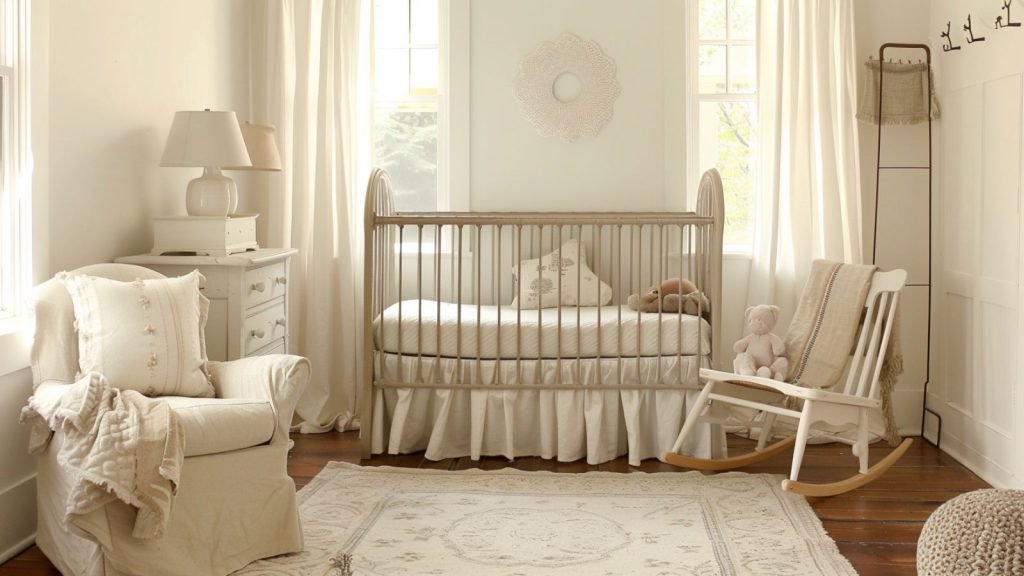
Incorporate soft, warm textiles to make the nursery feel cozy and inviting. Choose rugs, curtains, and blankets in gentle, soothing colors to create a comfortable environment for your precious baby. These elements add to the decor and create a nurturing atmosphere, perfect for playtime and rest.
16. Make Use of Underutilized Areas (ideas for small spaces, lot of space)
Explore underutilized spaces in the nursery, such as under the crib or behind the door, for additional storage options. These areas can house storage baskets, slim shelving units, or compact drawers, providing much-needed space to store toys, books, and other baby essentials without overwhelming the main nursery area.
17. Adopt a Minimalist Approach (decorate a space)
Adopting a minimalist approach in decorating your nursery can significantly free up space and reduce clutter. Select a few pieces of functional decor that add character to the room without taking up unnecessary space. This strategy helps maintain a spacious and breathable environment, making the nursery appear larger and more organized.
18. Storage Solutions for Essentials (keep your baby’s diapers and wipes)
Use dedicated storage solutions to organize essential baby items like diapers, wipes, and clothes. Wall-mounted dispensers, clear storage bins, and drawer organizers can keep these items neatly arranged and easily accessible. Prioritizing storage for essentials ensures you can quickly find what you need, keeping the nursery functional and clutter-free.
19. Prioritize Safety and Simplicity (perfect room, infant’s)
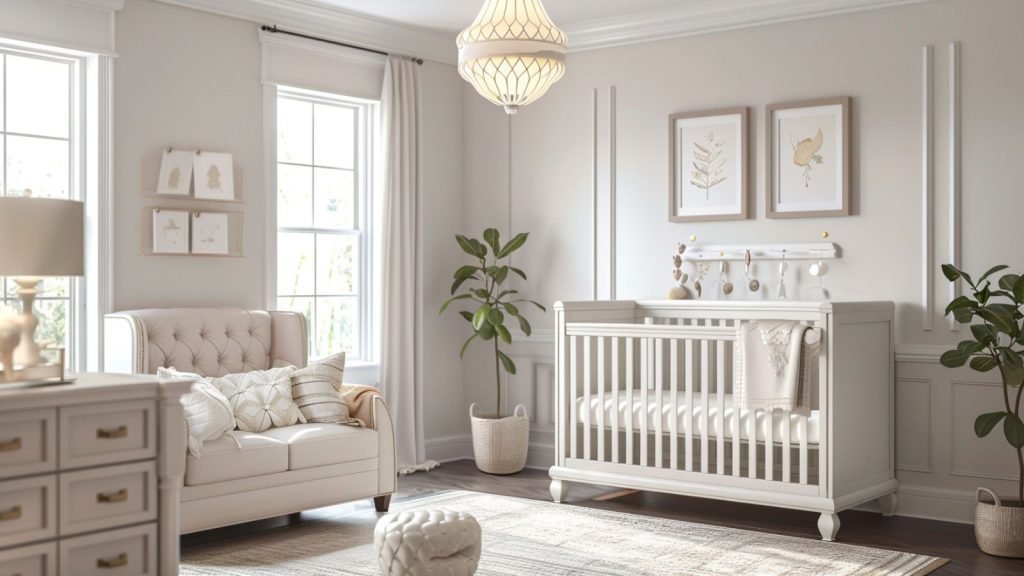
Ensure that every item in the nursery, from furniture to decor, is safe and secure for your infant. Avoid overdecorating, which can create hazards or clutter. Keep the design simple and focused on your baby’s needs, creating a safe, comfortable, and serene space where your little one can thrive.
20. Celebratory and Functional Decor (decorate baby’s nursery)
Choose nursery decor that is both celebratory and functional. Playful wall art with shelves, charming light fixtures, and decorative baskets enhances the nursery’s aesthetics and serves practical purposes. This approach lets you celebrate your baby’s arrival while ensuring the nursery remains tidy and well-organized.
21. Dual-purpose Play and Sleep Areas
Combine small nurseries’ sleeping and play areas to use the space efficiently. A soft, safe rug can define the play area during the day, while the same space can be calm and serene at night. Choosing multi-functional pieces ensures the nursery adapts to various needs without overcrowding.
22. Use Neutral Colors to Enhance Space
Decorating with neutral colors can make a small nursery feel larger and more open. Light walls reflect more natural light, enhancing the sense of space. Accents and decor can add splashes of color without overwhelming the room, keeping the environment soothing and airy.
23. Optimize Diaper Station Storage
Create an efficient diaper-changing station by using vertical space for storing diapers, wipes, and creams. A wall-mounted shelf or organizer beside the changing table or dresser can keep essentials within reach without taking up extra floor space, making diaper changes easier and the nursery less cluttered.
24. Incorporate Reflective Surfaces
Mirrors and other reflective surfaces can make a small nursery appear more spacious by reflecting light and views. Position mirrors strategically to maximize the sense of space and light, enhancing the nursery’s overall feel without requiring additional square footage.
25. Maximize Under-the-Crib Storage
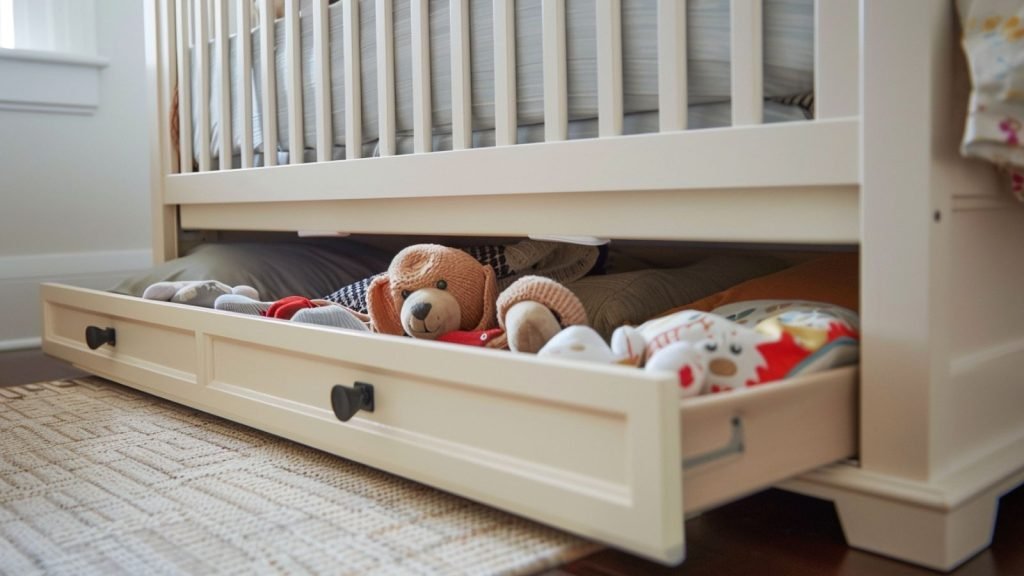
Consider beds or cribs with built-in drawers or place storage containers under the crib for extra linens, out-of-season clothing, or toys. This hidden storage solution utilizes space that would otherwise go unused, helping to keep the nursery organized and clutter-free.
26. Choose Light-filtering Window Treatments
Opt for light-filtering curtains or blinds that provide privacy and soft light without darkening the room. These window treatments can help maintain a bright, cheerful nursery during the day while ensuring a restful environment for naps and early bedtimes.
27. Create a Feature Wall with Decals or Paint
A feature wall with colorful decals or a painted mural can add depth and interest to a small nursery without taking up physical space. Choose themes that can grow with your child, offering a visually stimulating environment that doesn’t require additional furniture or decor items.
Summary
We’ve put together small nursery ideas to show that you don’t have to compromise style or function, even in a tight space. By getting creative with extra storage solutions – like using walls, over-the-door organizers, and walk-in closets – you can find plenty of room for your new baby’s needs.
These strategies are handy for decorating a small nursery, ensuring every inch of space is used efficiently. Whether turning unused space into storage or finding the perfect spot for toys, these tips will help keep your baby’s room organized, charming, and surprisingly spacious.
Frequently Asked Questions
How Do I Set Up a Small Nursery?
Start by choosing a mini crib to save space. Use vertical storage solutions like floating shelves and pegboards. Opt for multi-functional furniture, like a dresser that doubles as a changing table, to maximize utility without cluttering the room. Light colors and mirrors can make the room appear larger and more inviting.
How Do You Organize a Small Space in a Nursery?
To keep essentials tidy, utilize storage bins under the crib and over-the-door organizers. Incorporate wall shelves for items you need close at hand. Select furniture with storage capabilities to keep the floor clear and regularly declutter to maintain a serene space.
Where Should a Crib Be Placed in a Nursery?
Place the crib away from windows to avoid drafts and direct sunlight. Ensure it’s not against a wall with hanging pictures or shelves that could pose a risk. The crib should be easily accessible from the nursery door for quick check-ins.
How Big of a Room Do You Need for a Nursery?
There’s no one-size-fits-all answer, but a room as small as 7×10 feet can be sufficient for a nursery. The key is smart organization and selecting the right furniture to create a functional, comfortable space for your baby and you.
Which Bedroom to Make a Nursery?
Choose a bedroom close to yours to make nighttime feedings and check-ins more convenient. Consider the room’s temperature, noise level, and natural light before deciding. A quieter room with easy access to your bedroom is ideal.





